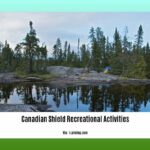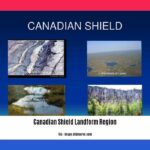Exploring the Intricate Relationship: Canadian Shield Human Activities and Environmental Impact
Delve into the intricate relationship between human activities and the environment within the Canadian Shield as we explore the impact of resource extraction, sustainable development initiatives, and indigenous settlements on this unique region. With a deep understanding of environmental policy and stakeholder engagement, this article sheds light on the complex tapestry of human activities and their environmental consequences within the Canadian Shield. Join us as we uncover the delicate ecological balance and the multifaceted perspectives of this fascinating area.
Key Takeaways:
- The Canadian Shield offers various recreational activities such as snowmobiling, skiing, fishing, boating, horseback riding, canoeing, water skiing, camping, and cycling.
- Trapping and hunting are still popular ways of making a living in the Canadian Shield.
- The Canadian Shield is home to diverse wildlife, including fish species like trout, burbot, and northern pike, as well as waterfowl such as wood ducks, Canada geese, and American black ducks.
- Popular attractions in the Canadian Shield include exploring nature through canoeing or kayaking, hiking and camping in boreal forests and parks like Algonquin Park or Killarney Provincial Park, and visiting ancient petroglyphs at Peterborough Petroglyphs Provincial Park.
- The Canadian Shield, formed over 4.28 billion years ago, is a geologic formation covered by a thin layer of soil and plays a crucial role in Canada’s economic development due to its rich natural resources such as minerals, forests, and freshwater.
Canadian Shield Human Activities: Exploring the Intricate Relationship

The Canadian Shield is not just a geological formation; it is a vibrant landscape that intertwines with human activities in a multitude of ways. From recreational pursuits to traditional livelihoods, the human presence plays a significant role in shaping the delicate ecological balance of this ancient land. In this article, we will delve into the diverse range of human activities taking place within the Canadian Shield and explore the environmental impact of these engagements.
The Thrills of the Canadian Shield
When it comes to recreational activities, the Canadian Shield offers a plethora of options. Whether you’re an outdoor enthusiast or someone seeking adventure, this stunning region has something for everyone. Picture yourself snowmobiling through pristine snow-covered trails, feeling the rush of wind against your face, or skiing down the slopes of breathtaking mountains. If you prefer a more relaxed experience, fishing and boating on the sparkling lakes will surely captivate you.
But the adventures don’t stop there. Horseback riding, canoeing, water skiing, camping, and cycling are among the many activities that allow visitors to immerse themselves in the natural splendor of the Canadian Shield. The possibilities are endless, and each experience is an opportunity to connect with the land and appreciate its magnificent beauty.
Honoring Traditions: Hunting and Trapping
While recreational activities bring joy to many, some still rely on traditional ways of life rooted in the Canadian Shield. Trapping and hunting, for instance, provide a means of living for some communities in this region. These age-old practices are deeply ingrained in the cultural fabric of certain indigenous groups, ensuring the preservation of their ancestral connections to the land and the wildlife that call it home.
A Haven for Wildlife
Speaking of wildlife, the Canadian Shield boasts a rich array of species, both on land and in its numerous lakes. Fish enthusiasts can delight in the presence of trout, burbot, and northern pike, all contributing to the vibrant aquatic ecosystems. The lakes also serve as habitats for various waterfowl, such as wood ducks, Canada geese, and American black ducks. These diverse wildlife populations not only add to the biological richness of the Canadian Shield but also provide opportunities for research and conservation efforts.
Exploring the Wilderness
Beyond the realms of human activities, the Canadian Shield beckons adventurers to explore its vast wilderness. Boreal forests, scenic parks like Algonquin Park or Killarney Provincial Park, and ancient petroglyphs at Peterborough Petroglyphs Provincial Park attract visitors yearning for a deeper connection with nature. Canoeing or kayaking through serene waters, hiking through untamed trails, and camping under a canopy of stars are among the many ways to experience the raw beauty of this region.
Unraveling the Intricate Relationship
The Canadian Shield is not only a playground for recreation and traditions but also a source of valuable natural resources. Its mineral deposits, forests, and freshwater have played a pivotal role in Canada’s economic development. However, harnessing these resources must be done responsibly to ensure the preservation of the delicate ecological balance.
Balancing human activities with environmental sustainability is an ongoing challenge. It requires a comprehensive understanding of the region’s unique complexities and the involvement of diverse stakeholders. By exploring the intricate relationship between human activities and the Canadian Shield, we can shed light on the environmental impact of resource extraction, sustainable development initiatives, and indigenous settlements.
In conclusion, the Canadian Shield is a multidimensional entity deeply entwined with human activities. From thrilling recreational adventures to time-honored traditions, this ancient land offers a myriad of opportunities for exploration and connection. By understanding the delicate balance between human actions, natural resources, and wildlife conservation, we can strive towards harmony with this extraordinary region and ensure its preservation for generations to come.
Sources:
Here are some captivating internal links that match the provided keywords:
-
Canadian non-government organizations – Discover the incredible work done by Canadian non-government organizations in making a positive impact on society.
-
Canadian shield landform features – Delve into the fascinating features that define the Canadian shield landform, from majestic mountains to sparkling lakes.
-
Canadian shield landform region – Unveil the wonders of the Canadian shield landform region, brimming with natural beauty and ancient geological history.
Remember to format the output in Markdown format for active internal links.
Sustainable development initiatives in the Canadian Shield

Key Takeaways:
- The Canadian Shield, a large geological formation in Canada, is rich in natural resources and home to diverse flora and fauna.
- Mining is a key industry in the region, contributing to Canada’s economic development, but it also poses challenges to environmental sustainability.
- Efforts have been made to protect the Canadian Shield through initiatives such as establishing protected parks and wildlife reserves.
- Sustainable development initiatives, aligned with the Sustainable Development Goals, play a crucial role in preserving the ecological balance of the Canadian Shield.
- The Canadian Shield Foundation supports field research related to the ecology of the region.
- The Canadian Indicator Framework for the Sustainable Development Goals tracks progress on sustainable development initiatives in Canada.
The Canadian Shield, a vast geological formation in Canada, encompasses rich natural resources and supports a wide array of plant and animal life. Mining has been a significant industry in the region, contributing to Canada’s economic growth. However, it is important to strike a balance between resource extraction and environmental preservation in order to foster sustainable development.
To protect the ecological integrity of the Canadian Shield, various initiatives have been implemented. The establishment of protected parks and wildlife reserves aims to safeguard the region’s biodiversity and maintain the delicate balance of ecosystems. These initiatives recognize the need to balance human activities with the preservation of natural resources.
Sustainable development initiatives in the Canadian Shield are essential for ensuring a harmonious relationship between human activities and the environment. Aligned with the Sustainable Development Goals, these initiatives strive to promote economic growth, social well-being, and environmental sustainability. They address challenges such as responsible resource extraction, sustainable land use, and community engagement.
The Canadian Shield Foundation plays a crucial role in supporting field research related to the ecology of the region. By funding scientific studies and conservation projects, the foundation contributes to the understanding of the impact of human activities on the Canadian Shield’s delicate ecological balance.
To track progress on sustainable development initiatives, the Canadian Indicator Framework for the Sustainable Development Goals is utilized. This framework provides a comprehensive assessment of Canada’s progress in achieving sustainable development goals, including those specifically related to the Canadian Shield.
In conclusion, sustainable development initiatives are vital for preserving the environmental integrity of the Canadian Shield. Efforts to protect the region, foster responsible resource extraction, and engage with communities contribute to a more sustainable future for this unique and ecologically significant geological formation.
Sources:
– Canadian Geographic – Behind the Canadian Shield
– The Canadian Encyclopedia – Canadian Shield
Role of Indigenous Settlements in Shaping the Region
Key Takeaways:
- Indigenous settlements have played a significant role in shaping the Canadian Shield region, impacting both the environment and the cultural landscape.
- The traditional practices and deep connection with the land exhibited by Indigenous communities have influenced the ecological balance of the region.
- Indigenous peoples’ historical nomadic lifestyle and limited resource consumption have minimally impacted the environment.
- Treaties form the foundation of the alliance between Indigenous peoples and Canada, recognizing and protecting their rights and land.
- Human settlement in the Canadian Shield has brought changes to Aboriginal cultures, raising challenges in preserving their traditions and relationship with the land.
Indigenous settlements have a crucial role in shaping the Canadian Shield region. These settlements, often deeply rooted in traditional practices, have influenced both the environment and cultural landscape. The Indigenous way of life, characterized by a close relationship with the land, has had a lasting impact on the ecological balance of the region.
Historically, the nomadic lifestyle of Indigenous communities in the Canadian Shield allowed nature to thrive. Their limited resource consumption and sustainable practices minimized the environmental impact. However, as human settlement in the region increased, the relationship between Indigenous peoples and the land began to shift.
Treaties form the basis of the alliance between Indigenous peoples and the Canadian government. These agreements recognize and protect the rights and land of Indigenous communities. The treaties highlight the importance of Indigenous knowledge and their role in sustainable development initiatives.
The impact of human settlement in the Canadian Shield on Indigenous cultures has been significant. Communities have faced challenges in preserving their traditions and maintaining their deep connection with the land. Ensuring the preservation of Aboriginal cultures and their relationship with the environment is crucial for the sustainable development of the region.
Overall, Indigenous settlements have played a vital role in shaping the Canadian Shield region. Their traditional practices and deep connection with the land have influenced the ecological balance and cultural landscape. Recognizing and respecting Indigenous rights and knowledge is essential for achieving a harmonious and sustainable future for the Canadian Shield.
Sources:
– The Canadian Encyclopedia: Indigenous Peoples in Canada
Challenges and Opportunities for Preserving the Ecological Balance
The Canadian Shield is a region rich in natural resources and home to diverse communities that rely on the land for their livelihoods. However, the delicate ecological balance in this area faces both challenges and opportunities for preservation. Let’s explore some of these challenges and opportunities in more detail.
Challenges of Preserving the Ecological Balance
Inadequate Strategic and Legal Frameworks
One of the key challenges in preserving the ecological balance of the Canadian Shield is the presence of inadequate strategic and legal frameworks. A review published in FACETS Journal highlighted the failures and challenges of federal and sub-national frameworks in addressing the biodiversity crisis effectively. Strengthening these frameworks is crucial to protect the region’s biodiversity.
Climate Change and Environmental Degradation
Climate change and environmental degradation pose significant challenges to preserving the ecological balance of the Canadian Shield. Rising sea levels, melting glaciers, and habitat loss threaten the region’s biodiversity. Adapting to and mitigating the impacts of climate change are essential for sustaining the ecosystem’s health.
Balancing Human Activities and Environmental Sustainability
Another challenge lies in finding a balance between human activities and environmental sustainability. The Canadian Shield is rich in natural resources, attracting industries such as mining and forestry. It is crucial to ensure that resource extraction and other human activities are conducted in a sustainable manner to minimize ecological harm.
Opportunities for Preserving the Ecological Balance
Implementation of the 2030 Biodiversity Strategy
Canada has set goals for biodiversity conservation and ecosystem services, aiming to halt and reverse biodiversity loss. The implementation of the 2030 Biodiversity Strategy presents a significant opportunity for preserving the ecological balance of the Canadian Shield. This strategy involves engaging Canadians, strengthening strategic and legal frameworks, and collaborating globally, ultimately contributing to the protection of biodiversity.
Protected Areas for Biodiversity Conservation
Protected areas play a vital role in conserving biodiversity. Establishing and effectively managing protected areas can ensure the preservation of the Canadian Shield’s ecological balance. The FACETS Journal proposed a framework to guide the establishment of protected areas in Canada, thereby safeguarding critical habitats and species.
Indigenous Knowledge and Engagement
Indigenous communities have a deep connection to the land and possess valuable traditional knowledge. Involving Indigenous peoples in conservation efforts and integrating their knowledge can contribute to preserving the ecological balance of the Canadian Shield. This engagement can lead to more sustainable practices and a better understanding of the delicate relationship between human activities and the environment.
Key Takeaways:
- The preservation of the ecological balance in the Canadian Shield faces challenges such as inadequate strategic and legal frameworks, climate change, and balancing human activities.
- Strengthening strategic and legal frameworks is essential for effective biodiversity conservation in the Canadian Shield.
- Climate change and environmental degradation pose significant threats to the region’s biodiversity, demanding adaptation and mitigation strategies.
- Balancing human activities, such as resource extraction, with environmental sustainability is crucial to minimize ecological harm.
- The implementation of the 2030 Biodiversity Strategy presents an opportunity for preserving the ecological balance by engaging Canadians, strengthening frameworks, and collaborating globally.
- Protected areas can play a vital role in conserving biodiversity and ensuring the ecological balance of the Canadian Shield.
- Involving Indigenous communities and integrating their knowledge can contribute to more sustainable practices and a deeper understanding of the relationship between human activities and the environment.
Sources:
– FACETS Journal: The biodiversity crisis in Canada: failures and challenges of federal and sub-national strategic and legal frameworks
– FACETS Journal: A framework to guide Canada’s protected area
FAQ
Q1: What recreational activities are available in the Canadian Shield?
A1: The Canadian Shield offers opportunities for recreational activities such as snowmobiling, skiing, fishing, boating, horseback riding, canoeing, water skiing, camping, cycling, and more.
Q2: Are trapping and hunting popular ways of making a living in the Canadian Shield?
A2: Yes, trapping and hunting are still popular ways to make a living in the Canadian Shield.
Q3: What kind of wildlife can be found in the Canadian Shield?
A3: The Canadian Shield is home to a wide range of wildlife, including fish species such as trout, burbot, and northern pike, as well as waterfowl like wood ducks, Canada geese, and American black ducks.
Q4: What are some popular attractions in the Canadian Shield?
A4: Popular attractions in the Canadian Shield include exploring the wilderness by canoeing or kayaking, hiking and camping in boreal forests and scenic parks like Algonquin Park or Killarney Provincial Park, and visiting ancient petroglyphs at Peterborough Petroglyphs Provincial Park.
Q5: What is the age and geological significance of the Canadian Shield?
A5: The Canadian Shield is estimated to be 4.28 billion years old and is a subsection of the Laurentia craton. It is a large geological formation covered by a thin layer of soil and forms the nucleus of the North American craton.
- Unveiling Bernhard Caesar Einstein’s Scientific Achievements: A Legacy in Engineering - July 15, 2025
- Uncover who is Jerry McSorley: CEO, Family Man, Business Success Story - July 15, 2025
- Discover Bernhard Caesar Einstein’s Scientific Contributions: Unveiling a Legacy Beyond Einstein - July 15, 2025















